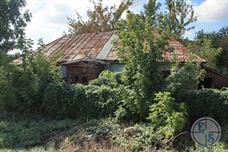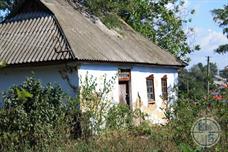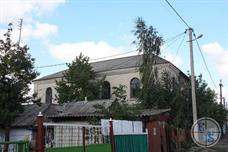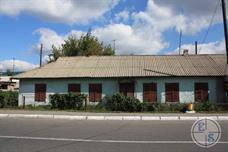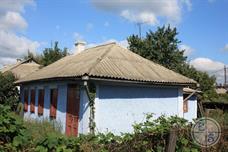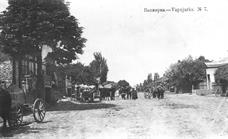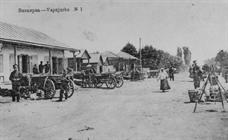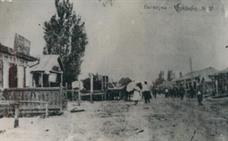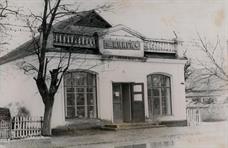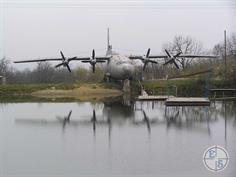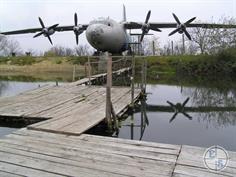Vapnyarka
Vapnyrka & Vysokoye, 1998 2012
Vapnyarka station was built in 1870 for laying the South-Western Railway and got its name from the neighboring village.
The value of plant has increased after 1899 was built line-Vapnyarka Hristinovka and Vapnyarka became a significant railway junction. There locomotive depot and opened railway school was built.
The value of plant has increased after 1899 was built line-Vapnyarka Hristinovka and Vapnyarka became a significant railway junction. There locomotive depot and opened railway school was built.
Jews began to settle in Vapnyarka since its inception, although according to "Provisional Regulations" of 1882 Jews were forbidden to "vodvoryatsya" in the countryside.
In 1897, 370 Jews lived Vapnyarka (49% of the population). Jews permit legalized only in 1903, when a special resolution for the Jewish settlement opened 291 village, including Vapnyarka. Probably because of the prohibition of Jews to acquire land in a rural Vapnyarka was no Jewish cemetery; Jews were buried in neighboring villages.
At the beginning of the XX century. in Vapnyarka it had 85 yards and a little less than 800 people, half of them Jews. At the railway station formed a commercial Jewish town, which were held on Fridays markets. Jews held about 30 different shops, as well as specific to the railway stations of agricultural machines stores (three), four warehouses and timber of kerosene. The settlement was a synagogue.
One of the ways the wave of pogroms autumn 1905 was walking along the railroad Southwestern Region. In the rioters Vapnyarka-Black Hundreds arrived by train from Odessa, October 20, 1905 With the support of the local population are a few hours robbed Jewish shops and homes.
During the Civil War in Vapnyarka it was created self-defense because of railroad workers, but it turned out to be unreliable, and many Jews fled to Tomashpol. 18 May 1919 60 (according to other sources 85) vapnyarskih Jews were collected at the station and killed gang Volynets, from 8 to 10 July spot robbed Bessarabian Regiment troops of the Directory, and in December - Denikin.
In 1897, 370 Jews lived Vapnyarka (49% of the population). Jews permit legalized only in 1903, when a special resolution for the Jewish settlement opened 291 village, including Vapnyarka. Probably because of the prohibition of Jews to acquire land in a rural Vapnyarka was no Jewish cemetery; Jews were buried in neighboring villages.
At the beginning of the XX century. in Vapnyarka it had 85 yards and a little less than 800 people, half of them Jews. At the railway station formed a commercial Jewish town, which were held on Fridays markets. Jews held about 30 different shops, as well as specific to the railway stations of agricultural machines stores (three), four warehouses and timber of kerosene. The settlement was a synagogue.
One of the ways the wave of pogroms autumn 1905 was walking along the railroad Southwestern Region. In the rioters Vapnyarka-Black Hundreds arrived by train from Odessa, October 20, 1905 With the support of the local population are a few hours robbed Jewish shops and homes.
During the Civil War in Vapnyarka it was created self-defense because of railroad workers, but it turned out to be unreliable, and many Jews fled to Tomashpol. 18 May 1919 60 (according to other sources 85) vapnyarskih Jews were collected at the station and killed gang Volynets, from 8 to 10 July spot robbed Bessarabian Regiment troops of the Directory, and in December - Denikin.
In 1923, 569 Jews lived Vapnyarka. From 1923 to 1930. Vapnyarka was a district center. Synagogue in Vapnyarka operated until the mid-1920s.
Before the Second World War in 1939, the Jewish population was 711 people (20% of the population).
By July 22, 1941, when German forces occupied Vapnyarka, the majority of local Jews were able to evacuate. The remaining 30 Jews were deported to Tulchin.
By the fall it is established Romanian occupation administration, and the concentration camp was organized in the barracks. In October 1941, there were placed about a thousand Jews from Odessa, as well as Ukrainians, and about a hundred criminals Baptists. By June 1942 about two hundred Jews died of typhus, and the rest were taken to the district of Ochakov and shot. In September 1942, Vapnyar ENGLISH camp was declared a political, it placed 1,200 Romanian Jews, accused of belonging to the Communists, among them prominent leaders of the Communist and Social Democratic parties. The camp consisted of three two-storey barracks, and was surrounded by three rows of barbed wire.
Before the Second World War in 1939, the Jewish population was 711 people (20% of the population).
By July 22, 1941, when German forces occupied Vapnyarka, the majority of local Jews were able to evacuate. The remaining 30 Jews were deported to Tulchin.
By the fall it is established Romanian occupation administration, and the concentration camp was organized in the barracks. In October 1941, there were placed about a thousand Jews from Odessa, as well as Ukrainians, and about a hundred criminals Baptists. By June 1942 about two hundred Jews died of typhus, and the rest were taken to the district of Ochakov and shot. In September 1942, Vapnyar ENGLISH camp was declared a political, it placed 1,200 Romanian Jews, accused of belonging to the Communists, among them prominent leaders of the Communist and Social Democratic parties. The camp consisted of three two-storey barracks, and was surrounded by three rows of barbed wire.
In the spring of 1943 about four camp inmates were placed in various ghettos of Transnistria. In October, the camp was closed and the remaining prisoners sent to the Romanian prison.
After the war, a large railway junction Vapnyarka lived several hundred Jews, mostly moved there from the surrounding small towns. Until the mid-1960s. in the village had its own Shoikhet, and until the mid-1970s. in a private house I was going to minyan. In 1970-ies. in Vapnyarka lived about a hundred Jews.
In 2012, the Jews do not live in Vapnyarka
V.Lukin, "100 Jewish settlements in Ukraine"
After the war, a large railway junction Vapnyarka lived several hundred Jews, mostly moved there from the surrounding small towns. Until the mid-1960s. in the village had its own Shoikhet, and until the mid-1970s. in a private house I was going to minyan. In 1970-ies. in Vapnyarka lived about a hundred Jews.
In 2012, the Jews do not live in Vapnyarka
V.Lukin, "100 Jewish settlements in Ukraine"
Just behind Vapnyarka, in the village of High, Pond offers impressive picture - just above the water, hangs a huge An-12, knows how flown here. It looks so impressive that obscures the impression of a more interesting, located opposite - a well with a hefty crane.
Vinnitsa Region

My shtetl
My shtetl
Jewish towns of Ukraine
Jewish towns of Ukraine
